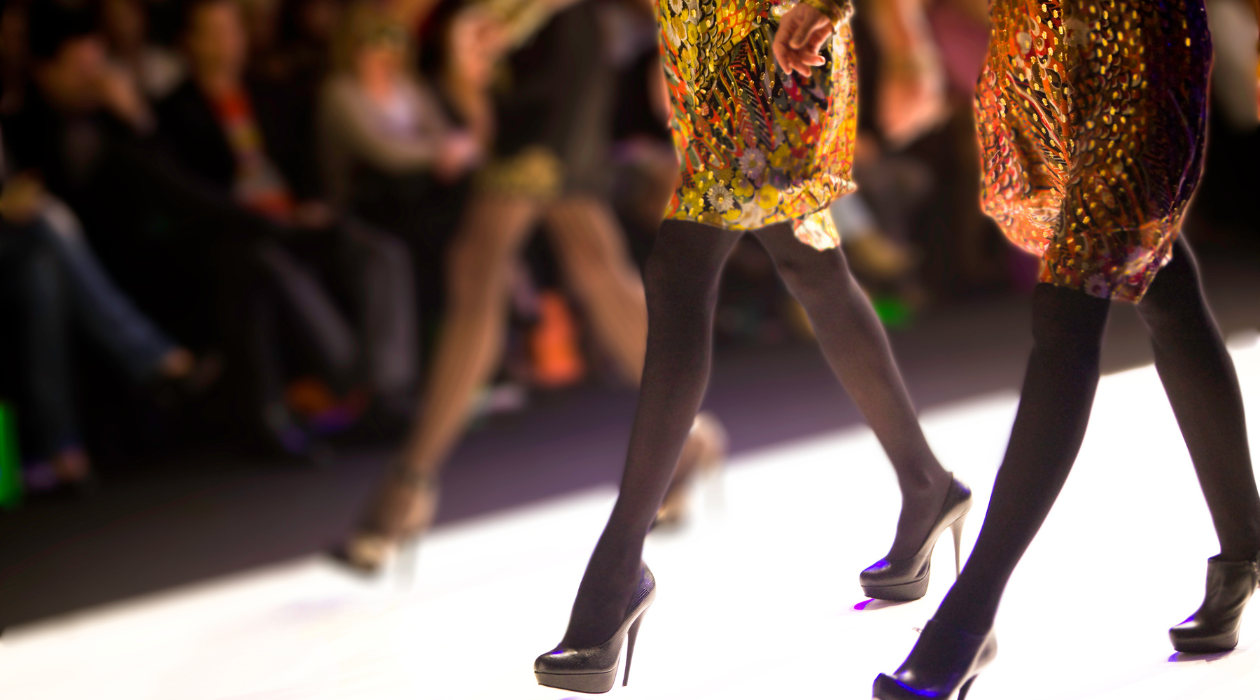Digital Fashion Shows Don’t Have to Be Boring

By Jean Scheidnes, Vice President [Header image credit: Canva]
Here comes another Fashion Month in which designers are prohibited from luring crowds to runway shows, and keep experimenting with ways to unveil their collections digitally. If runway shows were already anachronistic, stale, and formulaic before the pandemic—as some fashion insiders have argued—then a procession of models walking in clothes was perhaps even less exciting as a strictly digital experience. Astute designers have been seizing the moment to try more innovative and consumer-oriented ways of flexing their creative powers. With those experiments in mind, here are some strategies for standing out.
The Invitation as Mailer Campaign
Today’s runway audience is at home, passively consuming digital content. They didn’t put on a special outfit, walk past velvet ropes, or mingle with famous people. So where are the bragging rights? In the mail.
Some brands have reimagined their invitations and look books, basic tools of fashion PR, as VIP mailers. Loewe’s “show on the wall” wallpaper kit and Proenza Schouler’s coffee table book won raves from homebound editors and fashion influencers.

Of course, mailers have been a way to seed earned media from celebrities and influencers since long before the pandemic. The most successful seeding campaigns are thoughtful, personal, and creatively inspiring, according to Kate True, vice president of celebrity & influencer, who leads TMA’s VIP Relations practice.
“Celebrities and influencers are constantly inundated with free products. To break through, a brand must be intentional in the who, what, and why. At TMA, we never just send product on behalf of clients. We ensure that whatever we send is purpose-driven and will be positively received by the recipient,” says True.
The Front Row 2.0
Brands used to pay celebrities to attend shows and guarantee a media scrum. The practice has fallen off, obviously. But brands should not underestimate the persistent power of celebrities to draw attention. Chanel filmed its Métiers d’Art collection on a runway, in the presence of a single guest, Kristen Stewart, a longtime brand ambassador. The video shows her taking her seat at the beginning and giving a standing ovation at the end. The warmth of these small gestures offset the stiffness of the proceedings, and generated an explosion of headlines.

Getting in the Gaming Game
Last month Balenciaga launched a video game, Afterworld, to showcase its Fall 2021 collection. Users entered a purpose-built virtual world and navigated through spaces populated by avatars dressed in Balenciaga. As a virtual fashion experience, Afterworld was a bold experiment and a PR win. Perhaps “game” was a bit of a misnomer, as gameplay requires some combination of competition, challenge, strategy or chance.
“Any fashion brand that truly wants to tap into online gaming culture should consider partnering with game publishers to develop their brand’s unique presence within the game platform. Successful integrations will come at the intersection of what the player base wants, what value the brand can deliver to the ecosystem, and what innovation the publisher can bring. Tapping into top creators and influencers within that game’s community is also a must for amplification across social and content channels,” says Steve Meyers, gaming lead at TMA. Pro tip: These integrations take longer than you think.
Prioritize Music
The soundtrack is a vital dimension of the runway show experience. Brands typically hire a DJ to set the tone in the room. In show notes and interviews, designers will often draw connections to musical eras and artists that fueled their creativity in the atelier. But then these brands will release videos with anonymous, uninspiring music because it’s low-cost. Today, when video is the primary vehicle for the collection, music warrants more investment. Balenciaga’s Summer 2021 video wouldn’t have been as memorable without “Sunglasses at Night.”

Rihanna is a peerless forerunner of fashion as musical entertainment. Her Savage x Fenty lingerie brand had already broken the mold of the runway show with grand spectacles of performance, diversity, and star power since 2018. The brand moved from live theater to the small screen without losing a step. Not every brand can have a Rihanna, but they can all approach music as a forethought, rather than an afterthought.
“This doesn’t have to mean breaking the bank for an iconic song or major artist,” says Larry Weintraub, president of music & audio at TMA. “It could mean commissioning original music from an emerging artist, or perhaps tying up with a music sponsor that wants to be fashion-adjacent. Solutions exist, as long as the commitment to music is strong.” And these solutions can generate PR, which royalty-free music will never do.
Story Time
Fashion Month is now a de facto film festival, and production values can go quite high, with some brands borrowing talent from Hollywood. “Guccifest,” was a mini film festival anchored by a series co-directed by Gucci’s Alessandro Michele and Gus Van Sant. Celebrities in head-turning clothes? Check. Narrative arc? Well…to be fair, a plot has never been required of a fashion show. But if the audience is drawn to the premise of a series with actors and directors and Hollywood magic, something to propel the action is reasonably expected.
Maison Margiela gave us a 40-minute documentary of the creative process, interwoven with a tango-inspired fiction about a wedding —a double dose of narrative.
Marine Serre’s short art film didn’t need a plot, because it had suspense and foreboding in spades. The best runway shows leave audiences with an impression and a rush of feeling, which they’ll reference in their minds for months or years to come. Serre’s film nailed that.

The biggest lesson of the past year in fashion is that digital media require different areas of investment and different kinds of talent than runway shows. Most brands never had line items for screenwriting, music composition, or game development before. But it’s all converging now, creating the potential for a cultural renaissance in fashion.
After all, if brands want people to consume their presentations as entertainment, shouldn’t they be…entertaining?
Jean Scheidnes is a VP of Communications, Growth & Development at TMA, with over 20 years of experience in fashion media and luxury marketing.


